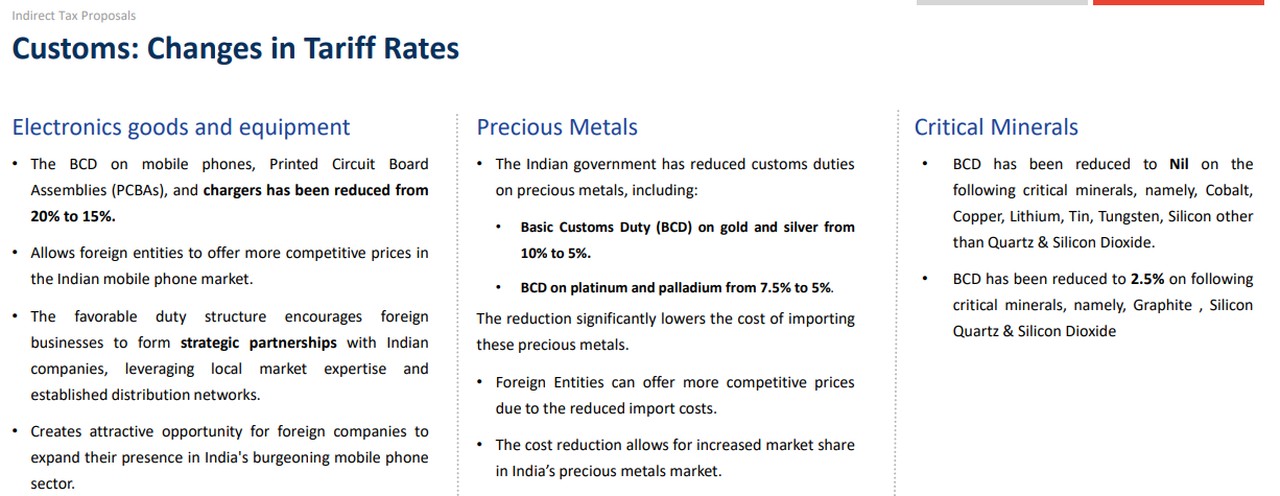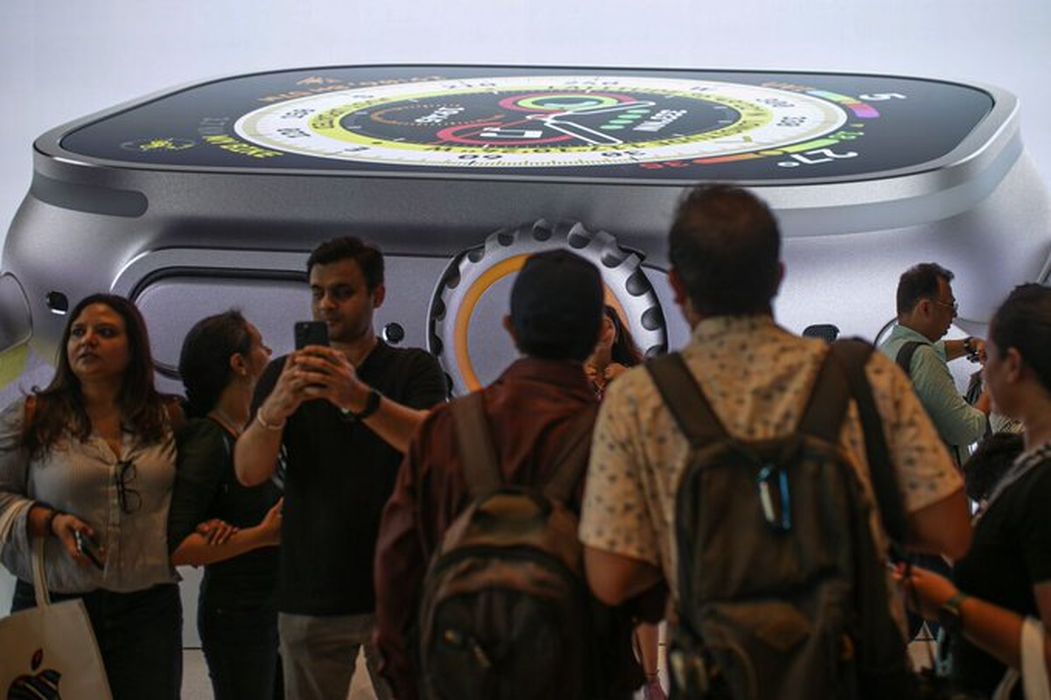
Charles R. Goulding and Preeti Sulibhavi consider how India’s 2024-2025 budget, with reduced tariffs on 3D printing materials, is poised to revolutionize manufacturing and electronics, making India a key player in global innovation.
India’s 2024-2025 budget involves a comprehensive range of changes to custom duties and a wide range of other business taxes. Now, that India’s economy is so strong and, in some cases, a preferable market to China, multinationals must keep current with important changes impacting cross-border business.
Custom Duties
One of the important changes directly impacting the 3D printing industry is the elimination of tariffs on a wide range of goods made from a variety of materials. These changes have far-reaching implications, particularly for industries reliant on cutting-edge technology, such as electronics and 3D printing. As India continues to position itself as a key player in global manufacturing, the reduced tariffs on goods like electronic components, certain metals, and polymers used in 3D printing are opening doors to increased innovation and production efficiency.
By slashing import duties on materials essential for 3D printing, the government aims to boost domestic production and technological innovation. This strategic decision aligns with India’s “Make in India” initiative, encouraging both local and global companies to invest in high-tech manufacturing within the country. Reduced costs for 3D printing materials mean companies can manufacture more complex parts domestically rather than importing expensive pre-made components.

Implications for the 3D Printing Industry
The 3D printing industry in India, though still emerging, stands to gain significantly from these changes. By reducing the financial barriers to importing necessary raw materials, the government is incentivizing the production of electronic components using 3D printing technology. Here’s how the 3D printing industry will benefit:
- Lower Costs of Raw Materials: 3D printers often rely on a combination of metals, polymers, and even organic materials. Reduced tariffs on these raw materials will directly lower production costs for companies using 3D printing, making the technology more accessible for small and medium enterprises (SMEs).
- Boost in R&D: With more affordable raw materials, companies will likely increase investment in research and development (R&D). This opens the door to new and innovative applications of 3D printing technology, particularly in electronics.
- Increased Adoption Across Sectors: The reduced cost of entry means more sectors—ranging from healthcare to automotive—will likely adopt 3D printing technology to create specialized components, driving growth in the industry.
One of the most exciting areas of expansion will be in consumer electronics, particularly mobile devices, and other smart appliances.
3D Printing in Electronics: A Game-Changer for Smartphones and Beyond
3D printing has already made significant inroads into the electronics industry, particularly with global companies like Apple, Samsung, and Nokia, using the technology for both prototyping and full-scale production. By enabling complex designs, reduced waste, and faster production cycles, 3D printing is becoming a core technology in the production of smartphones and other smart devices.
Apple and 3D Printing in Smartphone Manufacturing
Apple currently employs 150,000 in India and that number is expected to grow to 500,000 over the next three years.
Apple has long been at the forefront of innovation, and it is no stranger to 3D printing. The company has increasingly turned to 3D printing for rapid prototyping and production of components like smartphone cases, internal parts, and even custom accessories. With India’s reduced tariffs on electronic components, Apple could expand its 3D printing operations within the country, benefiting from lower material costs and faster supply chain processes.
For instance, 3D printing allows Apple to quickly prototype new designs for iPhone components such as circuit boards and internal structural elements. The precision and speed of 3D printing also means that Apple can develop highly customized products with unique geometries, something that traditional manufacturing techniques might struggle to achieve cost-effectively.
Samsung’s Use of 3D Printing for Smartphones and Smart Appliances
Samsung’s Indian headquarters is located in Gurgaon, India. It employs approximately 6,525 people as of 2022 and that number is growing.
Samsung, another leader in consumer electronics, has also adopted 3D printing to produce various components of its smartphones and smart home appliances. By using 3D printing, Samsung can experiment with advanced materials like high-strength plastics and lightweight metals to create components that are not only durable but also lighter and more efficient.
The ability to rapidly prototype using 3D printing has been a game-changer for Samsung’s R&D teams. With India’s new budget making key raw materials inexpensive, Samsung could potentially expand its operations in India, using 3D printing to locally produce smartphone casings, camera components, and other intricate parts required for its Galaxy series smartphones. Additionally, the company has explored the use of 3D printing to produce custom parts for smart refrigerators, washing machines, and other home appliances, which could become more cost-effective and widely available in the Indian market.

Nokia and the Future of 3D Printed Smartphones
In 2023, Nokia had approximately 16,800 employees based in India. In total, Nokia had around 86,700 employees worldwide in 2023, operating across 130 countries.
Nokia, although smaller than its competitors Apple and Samsung, has also been exploring 3D printing technologies, particularly for the design and development of internal smartphone components. With India’s new economic policies making raw materials and components more affordable, Nokia could leverage 3D printing to re-enter the highly competitive smartphone market in a stronger position.
Nokia has shown interest in 3D printing custom circuit boards, which could pave the way for modular smartphones that consumers can upgrade piece by piece. This level of customization would allow Nokia to cater to niche markets while keeping costs down, thanks to the reduced tariffs on the raw materials needed for 3D printing.
Broader Impact on Smart Devices and Appliances
Beyond smartphones, 3D printing holds immense potential for a wide range of electronic devices, from wearables to home appliances. Here are a few areas where 3D printing could have a transformative impact:
- Wearables: 3D printing enables the creation of highly customized wearable devices, such as fitness trackers and smartwatches, tailored to individual users’ needs. With reduced tariffs, companies in India can explore producing these devices domestically, reducing reliance on imports.
- Smart Home Devices: Companies could 3D print components for smart home devices like thermostats, security cameras, and smart speakers. This could lower production costs and lead to more affordable products for consumers, further driving the adoption of smart technologies in Indian households.
- Medical Devices: The intersection of electronics and 3D printing is also making waves in healthcare. Devices like hearing aids, pacemakers, and customized prosthetics can now be produced more quickly and affordably. With India emerging as a hub for medical technology (MedTech), these innovations could have widespread implications for healthcare accessibility.
How India’s Reduced Tariffs Could Shape the Future
The Indian government’s decision to reduce tariffs on raw materials crucial to the 3D printing industry will likely accelerate the adoption of this technology across multiple sectors. In electronics, this is particularly exciting, as it could lead to:
- Faster Production Cycles: 3D printing allows for rapid prototyping and production, enabling companies to bring products to market faster than ever before.
- Cost Savings: The reduction in tariffs will lower the cost of materials and components, leading to more affordable electronic devices for Indian consumers.
- Increased Local Manufacturing: Global tech companies like Apple, Samsung, and Nokia are likely to expand their manufacturing footprints in India, using 3D printing to produce high-quality components domestically.
- Innovation and Customization: With lower costs, companies can invest more in R&D, resulting in highly customized, innovative electronic products that cater to specific consumer needs.
The Research & Development Tax Credit
The now permanent Research and Development (R&D) Tax Credit is available for companies developing new or improved products, processes and/or software.
3D printing can help boost a company’s R&D Tax Credits. Wages for technical employees creating, testing and revising 3D printed prototypes can be included as a percentage of eligible time spent for the R&D Tax Credit. Similarly, when used as a method of improving a process, time spent integrating 3D printing hardware and software counts as an eligible activity. Lastly, when used for modeling and preproduction, the costs of filaments consumed during the development process may also be recovered.
Whether it is used for creating and testing prototypes or for final production, 3D printing is a great indicator that R&D Credit-eligible activities are taking place. Companies implementing this technology at any point should consider taking advantage of R&D Tax Credits.
Conclusion
India’s 2024-2025 budget has set the stage for significant growth in the 3D printing and electronics industries. By reducing tariffs on crucial raw materials, the government has made it easier for both local and international companies to invest in advanced manufacturing technologies. For the electronics sector, this opens new possibilities for smartphones, smart devices, and home appliances, with global companies like Apple, Samsung, and Nokia leading the charge. As India continues to grow as a global tech hub, the intersection of 3D printing and electronics promises to deliver faster, inexpensive, and more innovative products for consumers worldwide.
